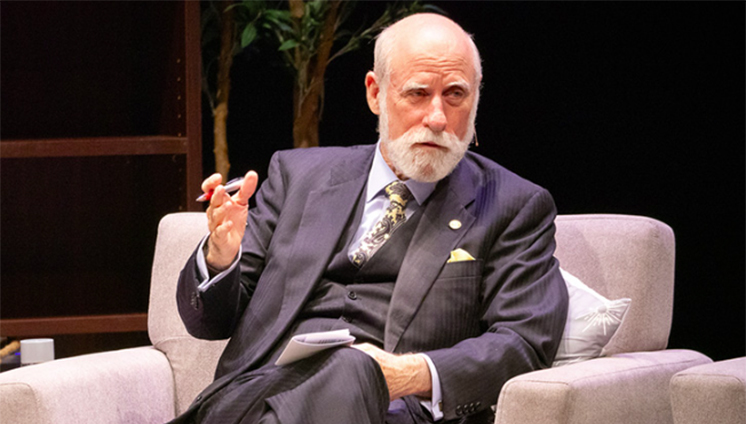Vinton G. Cerf: Father of the Internet and a Tech Visionary.
Vinton “Vint” G. Cerf is vice president and Chief Internet Evangelist for Google. He is considered one of the “Fathers of the Internet” for his pioneering work as a co-designer on the TCP/IP protocol in the 1970s and beyond. Cerf is an influential voice on Internet policy and technology issues like privacy and security.
With the rise of more interactive and speed-sensitive Internet applications, Cerf has supported new protocols to optimize TCP/IP performance. He wrote in Communications of the ACM in 2015: “The ‘quickness’ of QUIC derives from four key design decisions, including reduced connection establishment time, encrypted packet headers, integration of congestion control with loss recovery, and a new transport layer security protocol.”

1997, President Bill Clinton Presents the U.S. National Medal of Technology to Vint Cerf and Bob Kahn.
Privacy and security issues emerged alongside Internet evolution, as Cerf has observed: “I think forevermore we have lost anonymity and privacy in the digital world. It’s the case that anything you do electronically can be monitored.” The shift to an online environment to accomplish different tasks has shown that privacy is hard to come by.
Cerf narrates how society perceived privacy when the telephone was invented. In his remarks, unlike in the village where everyone knew everybody, life in the cities and industrial districts was anonymous as people were strangers. In the early days, anonymity was likened to privacy. Now, nearly everyone has a mobile phone with access to applications such as cameras and voice recorders.
Faced with a proliferation of devices, Cerf argues that there is a great deal of concern for safety, security, and privacy. He believes that while there is a strong yearning for privacy and even anonymity, there is this other side of the coin that says we unequivocally have to have a strong way of authenticating people so that someone else can’t do that.
Equally, companies like Meta or Google accumulate user data, which can be shared upon request to government agencies. The side effects of sharing information continue to be experienced.
Cerf presents an example of someone photographing a pyramid in Egypt, and he captures a stranger in the photo. When this photo is uploaded on the internet, like Facebook, another person searching for a pyramid sees the stranger in the photo, a stranger who was allegedly in London. He sees protecting privacy as an ongoing challenge that requires continuous vigilance, not just technical solutions. According to him, protecting citizens’ privacy in the digital world is an ongoing struggle where the right balance must be found.

Vint Cerf Addresses Audiences at the National Press Club.
Similarly, Cerf believes security vulnerabilities are unavoidable aspects of complex, interconnected systems. In the earlier days of finalizing the internet protocols, Cerf thought that building security into the internet when it launched was not a good idea as it would have lowered usage. Security requires that the user remember and maintain their password keys or risk being locked out of the network. Difficulties using the network and college students’ insufficient ‘discipline’ to remember the password keys contributed to the security vulnerability to be addressed in later years. He views that we are moving back towards the end-to-end principle, and by adopting the philosophy of not communicating with some devices we do not recognize, we are headed towards improved security on the network.

Vint Cerf Extends Support to Tech Graduate Students at Stanford.
Cerf stresses pragmatic mitigation efforts focused on specific threats rather than seeking any final “fix.” He notes that the big challenge is to continue being open to innovation while limiting vulnerabilities and dealing with threats by designing specific solutions for specific problems. Still, no one solution will do it all.
In conclusion, according to Cerf’s view, privacy and security issues are unavoidable in the digital world. They need one to see them as constantly evolving challenges that ought to be met with sustained focus and effort over time. There will never be perfect or one-size-fits-all solutions that allow full complacency.
References
Cerf, Vinton G., “Invention.” Communications of the ACM, July 23, 2015. https://doi.org/10.1145/2798333.
“Digital Democracy: Past, Present, and Future An Interview with Vinton G. Cerf, Vice President and Chief Internet Evangelist, Google.” Accessed December 18, 2023. https://dl.acm.org/doi/pdf/10.1145/3382738.
Google Cloud Platform Podcast. “Vint Cerf: Past, Present, and Future of the Internet,” October 25, 2017. https://www.gcppodcast.com/post/episode-100-vint-cerf/.
NewMediaConsortium. “2011 NMC Fellows Award: Q&A with Vint Cerf.” YouTube, September 9, 2011. https://www.youtube.com/watch?v=tFpB1R59EFY.
USC Price. “An Interview with Vint Cerf.” YouTube, December 19, 2018. https://www.youtube.com/watch?v=E9NHy7MCGm0.
Wolverton, Troy. “The Internet’s ‘father’ Says It Was Born with Two Big Flaws (GOOGL).” Business Insider Africa, January 20, 2019. https://africa.businessinsider.com/tech/the-internets-father-says-it-was-born-with-two-big-flaws-googl/0339etj.

Vint Cerf gives a talk at Heidelberg Laureate Forum in Germany in 2014.

Vint gives a talk at National Library of New Zealand

Vint supports Tech graduate students at Stanford

Vint speaks with Global Viewpoint Network editor Nathan Gardels about internet rights on March 8, 2012.

Dr. Vint Cerf takes questions from Naval Postgraduate School students, faculty and staff during his Secretary of the Navy Guest Lecture, March 5, 2018.

Vint speaking at National Press Club

Vint speaking at UCLA in 2019 during the 50th birthday of internet
Books he has authored and co-authored

Published January 22, 2014.
Awards

Heidelberg Lecture by Vint during the (ACM A.M Turning Awards 2004) in 2016










